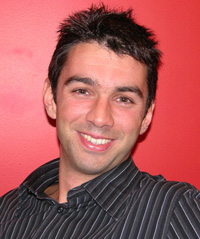 Dr. Cyrille Boyer received his PhD in polymer chemistry in 2005 from the University of Montpellier II. His PhD was in collaboration with Solvay-Solexis and devoted to the synthesis of new graft copolymers using grafting “onto” under the supervision of Prof. B. Boutevin and Prof. J.J. Robin. In 2005, he undertook an engineer position with Dupont Performance and Elastomers dealing with the synthesis of original fluorinated elastomers using controlled radical polymerization (e.g., iodine transfer polymerization). In October 2006, he joined the Centre for Advanced Macromolecular Design (CAMD) as a senior research fellow under the direction of Prof. Tom Davis. In 2009, he got an Australian Post-Doctoral Fellowship from the Australian Research Council (ARC). Recently, Dr. Cyrille Boyer has been appointed as a Nanomedicine Lecturer at the University of New South Wales. His research interests mainly cover the preparation of well-defined polymers for drug delivery and imaging applications, protein-polymer conjugates and hybrid organic-inorganic nanoparticles using controlled radical polymerization. He is also working on the preparation of new systems for energy storage using hybrid organic/inorganic nanomaterials. He has co-authored over 70 peer-reviewed research papers, including two book chapters and two international patents.
Dr. Cyrille Boyer received his PhD in polymer chemistry in 2005 from the University of Montpellier II. His PhD was in collaboration with Solvay-Solexis and devoted to the synthesis of new graft copolymers using grafting “onto” under the supervision of Prof. B. Boutevin and Prof. J.J. Robin. In 2005, he undertook an engineer position with Dupont Performance and Elastomers dealing with the synthesis of original fluorinated elastomers using controlled radical polymerization (e.g., iodine transfer polymerization). In October 2006, he joined the Centre for Advanced Macromolecular Design (CAMD) as a senior research fellow under the direction of Prof. Tom Davis. In 2009, he got an Australian Post-Doctoral Fellowship from the Australian Research Council (ARC). Recently, Dr. Cyrille Boyer has been appointed as a Nanomedicine Lecturer at the University of New South Wales. His research interests mainly cover the preparation of well-defined polymers for drug delivery and imaging applications, protein-polymer conjugates and hybrid organic-inorganic nanoparticles using controlled radical polymerization. He is also working on the preparation of new systems for energy storage using hybrid organic/inorganic nanomaterials. He has co-authored over 70 peer-reviewed research papers, including two book chapters and two international patents.
Please follow the link to get more information about Cyrille’s laboratory and his recent paper in Polymer Chemistry.What was your inspiration in becoming a chemist?
When I was a child, I was very interested in science, in particular chemistry. With chemistry, it is possible to construct/build complex molecules from basic compounds. It is like playing LEGO at the molecular level. I enjoy the bench work and exploring new types of chemistry. My recent Nanomedicine Lectureship position allows me to use my knowledge in polymer sciences to prepare new nanomaterials for applications in nanomedicine. Currently, I am involved in developing new therapies for neuroblastoma and liver diseases in collaboration with Children’s Cancer Institute Australia and Westmead Millennium Institute.
What was the motivation behind the research in your recent Polymer Chemistry paper? (DOI: 10.1039/c1py00102g)
The star polymer structure presents very interesting properties for bio-applications due to their small size as underlined by the great work of Kris Matyjaszewsky (Carnegie Mellon) and Gregg Qiao (University of Melbourne). However, when I started to work on star polymers, I realized it was very difficult to obtain well-defined star polymers with a very high incorporation of arms using the RAFT process and decided to focus my efforts to optimize this process in collaboration with Dave Haddleton, Mike Whittaker and Tom Davis. Now with this recent success, we are very excited and will continue our work with the plan to exploit these star polymers for drug/gene delivery and for imaging applications.
Why did you choose Polymer Chemistry to publish your work?
I believe this journal has a huge potential and it will become one of the top journals in polymer science. I was immediately impressed with the high quality papers that appeared in the first edition.
In which upcoming conferences may our readers meet you?
I am going to Frontiers in Polymer Science at the end of May in Lyon (France), American Chemical Society in Denver at the end of August. At these conferences, I will be presenting the latest outcomes of this on-going research program into RAFT polymer stars. I am also organising a special “Early Career Researcher” symposium as part of the 2nd International Nanomedicine Conference to be held in Sydney July 2011 (http://oznanomed.org/). It’s 3 days of great science and I welcome everyone to attend.
How do you spend your spare time?
I like to go to the cinema with friends, and practice sport. When I am on my own I always enjoy a good book.
Which profession would you choose if you were not a scientist?
I would love to be a wine maker because I like to drink good wine and my family has some experience in the wine industry. My parents operate a vineyard in the area of Avignon (France); “La Bignande Des Clos”. This is still possible and perhaps something I will consider when I will retire…










